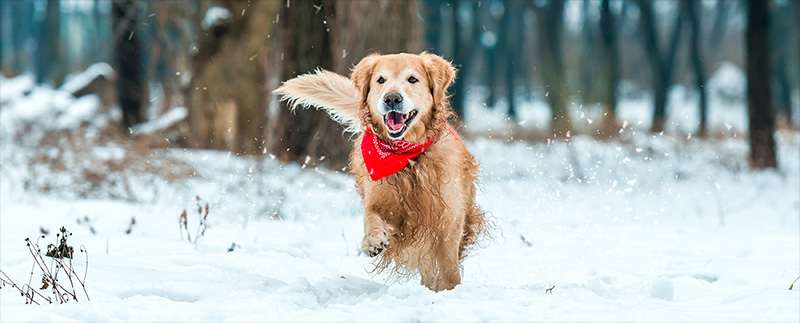Let's face it: even though Punxsutawney Phil predicted an early spring, cold weather is still here for a lot of us. For pet parents who live in an area where frigid temperatures are likely to continue, it's important not to forgo exercise just because it's cold. It's equally as important to continue safety precautions with your pup no matter their age or size. That's why we've rounded up our top winter safety tips to ensure your dog is healthy and happy.
 Protect the paws. Make sure to thoroughly wipe down your dog when they come back into the house after being in the snow or ice. Especially their paws as it’s common for dogs to ingest ice melt salts from the ground by licking their paws when they are back in the house. Ice melt salts can cause dogs to vomit or have diarrhea.
Protect the paws. Make sure to thoroughly wipe down your dog when they come back into the house after being in the snow or ice. Especially their paws as it’s common for dogs to ingest ice melt salts from the ground by licking their paws when they are back in the house. Ice melt salts can cause dogs to vomit or have diarrhea.
Pro tip: If you notice your dog's paws becoming irritated, talk to your vet about dog booties. Though we suggest giving them a try, take their boots off if they start acting strange or if they try to rip them off.
 Be mindful if you let your pup roam free in the snow. Dogs tend to lose their sense of smell in extremely cold weather and become lost. Believe it or not, winter has the highest rates for lost dogs!
Be mindful if you let your pup roam free in the snow. Dogs tend to lose their sense of smell in extremely cold weather and become lost. Believe it or not, winter has the highest rates for lost dogs!
 Freshwater is always a must. Your dog may be more likely to lick ice and eat snow if he/she is thirsty from lack of water. While hydrating this way, your dog may ingest poisonous antifreeze.
Freshwater is always a must. Your dog may be more likely to lick ice and eat snow if he/she is thirsty from lack of water. While hydrating this way, your dog may ingest poisonous antifreeze.
Pro tip: If there’s only a light dusting of snow (typically anything less than 2-inches) don’t let your dog lick the snow, as they’ll likely be licking the sidewalk and therefore dangerous substances.
 Does your dog's meal plan need revision? During the winter months, your dog isn’t as active, so feeding them too much will only make them more sluggish. Also, changing the flavor of their food will make their meals more exciting, but stay with the same brand to minimize any tummy issues.
Does your dog's meal plan need revision? During the winter months, your dog isn’t as active, so feeding them too much will only make them more sluggish. Also, changing the flavor of their food will make their meals more exciting, but stay with the same brand to minimize any tummy issues.
Pro tip: If your dog is maintaining a healthy amount of exercise during the winter, you may need to consider that exercising in cold weather depletes more energy as the body works extra hard to stay warm. If this is the case then make sure your dog has plenty of food after a workout.
 Prep them before going outside. Avoid the shock of cold weather by getting your dog’s blood pumping before going outside. Just as you stretch to get your muscles warm, toss or roll a soft ball in the house a couple times for your dog to chase after.
Prep them before going outside. Avoid the shock of cold weather by getting your dog’s blood pumping before going outside. Just as you stretch to get your muscles warm, toss or roll a soft ball in the house a couple times for your dog to chase after.
Pro tip: Typically, dogs will be comfortable so long as the temperature is above 45 degrees F. Once it hits below, you should think twice about taking Fido out for long periods of time.
 Keep time outside short! It’s important to let your pup play around in the cold/snow – because they will love it! However, always supervise them and never let them stay outside for too long. In addition to losing their sense of smell quicker in cold weather, dogs tend to get colder faster because of their bare paws are on the ground.
Keep time outside short! It’s important to let your pup play around in the cold/snow – because they will love it! However, always supervise them and never let them stay outside for too long. In addition to losing their sense of smell quicker in cold weather, dogs tend to get colder faster because of their bare paws are on the ground.
Pro tip: If you have a dog that has short hair, a puppy or a senior dog, you might want to purchase a jacket or sweater for them if they go out in the cold for any bit of time.

